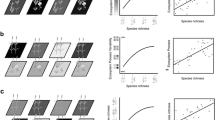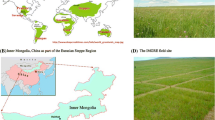Abstract
Context
Spatial heterogeneity is ubiquitous in ecological systems, and has important effects on biological diversity and ecological processes.
Objectives
Does spatial heterogeneity affect the relationship between biodiversity and ecosystem functioning (BEF)? To help address this question, this study investigated how the spatial patterns of key BEF variables changed before and after the biodiversity removal during a BEF experiment in China.
Methods
Our analysis was based on data from the Inner Mongolia grassland removal experiment (IMGRE) which was conducted in the Xilingol Steppe, Inner Mongolia, China. We quantified the spatial patterns of key variables of BEF, and examined the spatial relationships among these variables, using biodiversity indices and spatial statistical methods (autocorrelation and semivariance analysis).
Results
Our results show that the variables of BEF in the Inner Mongolian grassland had various spatial patterns, most of which were spatially correlated to each other. Removal treatments had significant effects on these spatial structures and correlations. These effects were diverse in terms of both their kinds and magnitudes because of different removal protocols and treatments.
Conclusions
The differences in spatial patterns of plant and soil variables and their correlations before and after the biodiversity manipulation do not necessarily imply that the results from BEF experiments like IMGRE are invalid, but they do suggest that the possible effects of spatial heterogeneity on the BEF relationship should be further scrutinized in future studies.






Similar content being viewed by others
References
Bai Y, Han X, Wu J, Chen Z, Li L (2004) Ecosystem stability and compensatory effects in the Inner Mongolia Grassland. Nature 431:181–184
Bai Y, Wu J, Clark CM, Naeem S, Pan QM, Huang JH, Zhang LX, Han XG (2010) Tradeoffs and thresholds in the effects of nitrogen addition on biodiversity and ecosystem functioning: evidence from Inner Mongolia Grasslands. Glob Change Biol 16(1):358–372
Burrough PA (1995) Spatial aspects of ecological data. In: Jongman RHG, ter Braak CJF, Van Tongeren OFR (eds) Data analysis in community and landscape ecology. Cambridge University Press, Cambridge, pp 213–265
Cardinale BJ, Duffy JE, Gonzalez A, Hooper DU, Perrings C, Venail P, Narwani A, Mace GM, Tilman D, Wardle DA, Kinzig AP, Daily GC, Loreau M, Grace JB, Larigauderie A, Srivastava DS, Naeem S (2012) Biodiversity loss and its impact on humanity. Nature 486(7401):59–67
Chapin FS, Walker B, Hobbs R (1997) Biotic control over the functioning of ecosystems. Science 277(Jul 25):500–504
Chapin III FS, Zavaleta ES, Eviner VT, Naylor RL, Vitousek PM, Reynolds HL, Hooper DU, Lavorel S, Sala OE, Hobbie SE, Mack MC, Diaz S (2000) Consequences of changing biodiversity. Nature 405(6783):234–242
Clifford P, Richardson S, Hémon D (1989) Assessing the significance of the correlation between to spatial processes. Biometrics 45:123–134
Diaz S, Symstad AJ, Chapin FS III, Wardle DA, Huenneke LF (2003) Functional diversity revealed by removal experiments. Trends Ecol Evol 18:140–146
Fortin M-J, Dale MRT (2005) Spatial analysis: a guide for ecologists. Cambridge University Press, Cambridge
Foster J, Townsend P, Mladenoff D (2013) Spatial dynamics of a gypsy moth defoliation outbreak and dependence on habitat characteristics. Landscape Ecol 28(7):1307–1320
Gross K, Pregitzer K, Burton AJ (1995) Spatial variation in nitrogen availability in three successional plant communities. J Ecol 83:357–367
Gundale MJ, Wardle DA, Nilsson M-C (2010) Vascular plant removal effects on biological N fixation vary across a boreal forest island gradient. Ecology 91(6):1704–1714
Guo D, Mou PP, Jones RH, Mitchell RJ (2002) Temporal changes in spatial patterns of soil moisture following disturbance: an experimental approach. J Ecol 90:338–347
Jackson RB, Caldwell MM (1993a) The scale of nutrient heterogeneity around individual plants and its quantification with geostatistics. Ecology 74:612–614
Jackson RB, Caldwell MM (1993b) Geostatistical patterns of soil heterogeneity around individual plants. J Ecol 81:683–692
Keitt TH, Bjornstad ON, Dixon PM, Citron-Pousty S (2002) Accounting for spatial pattern when modeling organism–environment interactions. Ecography 25:616–625
Legendre P, Fortin MJ (1989) Spatial pattern and ecological analysis. Vegetatio 80:107–138
Levin SA (1992) The problem of pattern and scale in ecology. Ecology 73:1943–1967
Li H, Reynolds JF (1995) On definition and quantification of heterogeneity. Oikos 73(2):280–284
Li A, Wu JG, Huang JH (2012) Distinguishing between human-induced and climate-driven vegetation changes: a critical application of RESTREND in Inner Mongolia. Landscape Ecol 27(7):969–982
Loreau M, Naeem S, Inchausti P (eds) (2002) Biodiversity and ecosystem functioning: synthesis and perspectives. Oxford University Press, Oxford
McLellan AJ, Law R, Fitter AH (1997) Response of calcareous grassland plant species to diffuse competition: results from a removal experiment. J Ecol 85(4):479–490
Meisel JE, Turner MG (1998) Scale detection in real and artificial landscapes using semivariance analysis. Landscape Ecol 13(6):347–362
Moran PAP (1948) The interpretation of statistical maps. J R Stat Soc B 10:243–251
Mueller EN, Wainwright J, Parsons AJ (2008) Spatial variability of soil and nutrient characteristics of semi-arid grasslands and shrublands, Jornada Basin, New Mexico. Ecohydrology 1:3–12
Naeem S, Bunker DE, Hector A, Loreau M, Perrings C (eds) (2009) Biodiversity, ecosystem functioning, and human wellbeing: an ecological and economic perspective. Oxford University Press, Oxford
Naeem S, Duffy JE, Zavaleta E (2012) The functions of biological diversity in an age of extinction. Science 336:1401–1406
Robertson GP, Gross KL (1994) Assessing the heterogeneity of belowground resources: quantifying pattern and scale. In: Caldwell MM, Pearcy RW (eds) Exploitation of environmental heterogeneity by plants: ecophysiological processes above- and belowground. Academic Press, San Diego, pp 237–253
Robertson GP, Huston MA, Evans FC, Tiedje JM (1988) Spatial variability in a successional plant community: patterns of nitrogen availability. Ecology 69:1517–1524
Robertson GP, Crum JR, Ellis BG (1993) The spatial variability of soil resources following long-term disturbance. Oecologia 96:451–456
Rossi RE, Mulla DJ, Journel AG, Franz EH (1992) Geostatistical tools for modeling and interpreting ecological spatial dependence. Ecol Monogr 62(2):277–314
Saetre P (1999) Spatial patterns of ground vegetation, soil microbial biomass and activity in a mixed spruce-birch stand. Ecography 22:183–192
Schlesinger WH, Raikes JA, Hartley AE, Cross AE (1996) On the spatial pattern of soil nutrients in desert ecosystems. Ecology 77(2):364–374
Schroeer AE, Hendrick RL, Harrington TB (1999) Root, ground cover, and litterfall dynamics within canopy gaps in a slash pine (Pinus elliottii Engelm.) dominated forest. Ecoscience 6:548–555
Silver WL, Vogt KA (1993) Fine root dynamics following single and multiple disturbances in a subtropical wet forest ecosystem. J Ecol 81:729–738
Vasques GM, Grunwald S, Myers DB (2012) Associations between soil carbon and ecological landscape variables at escalating spatial scales in Florida, USA. Landscape Ecol 27(3):355–367
Wardle DA, Bonner KI, Barker GM, Yeates GW, Nicholson KS, Bardgett RD, Watson RN, Ghani A (1999) Plant removals in perennial grassland: vegetation dynamics, decomposers, soil biodiversity, and ecosystem properties. Ecol Monogr 69(4):535–568
Wu J (2013) Landscape sustainability science: ecosystem services and human well-being in changing landscapes. Landscape Ecol 28:999–1023
Wu J, Levin SA (1994) A spatial patch dynamic modeling approach to pattern and process in an annual grassland. Ecol Monogr 64(4):447–464
Wu J, Loucks OL (1992) Xilingole grassland. In: US National Research Council (ed) Grasslands and grassland sciences in northern China. National Academy Press, Washington, DC, pp 67–84
Wu J, Loucks OL (1995) From balance-of-nature to hierarchical patch dynamics: a paradigm shift in ecology. Q Rev Biol 70:439–466
Wu J, Naeem S, Elser JJ, Bai Y, Huang J, Kang L, Pan Q, Wang Q, Hao S, Han X (2015) Testing biodiversity–ecosystem functioning relationship in the world’s largest grassland: overview of the IMGRE project. Landscape Ecol. doi:10.1007/s10980-015-0155-y
Acknowledgments
We thank Xiaotao Lü, Qingmin Pan, Meng Wang and Qibing Wang for their assistance with some of the data acquisition. This study was supported by Grants from National Science Foundation (DEB-0618193), National Natural Science Foundation of China (30830026), and National Basic Research Program of China (973 Program, 2007CB106801).
Author information
Authors and Affiliations
Corresponding author
Rights and permissions
About this article
Cite this article
Yuan, F., Wu, J., Li, A. et al. Spatial patterns of soil nutrients, plant diversity, and aboveground biomass in the Inner Mongolia grassland: before and after a biodiversity removal experiment. Landscape Ecol 30, 1737–1750 (2015). https://doi.org/10.1007/s10980-015-0154-z
Received:
Accepted:
Published:
Issue Date:
DOI: https://doi.org/10.1007/s10980-015-0154-z




